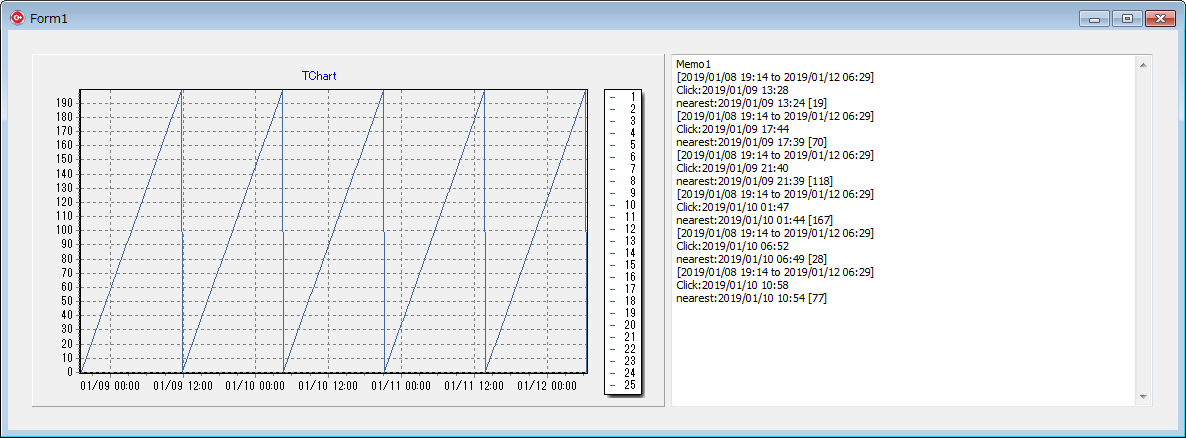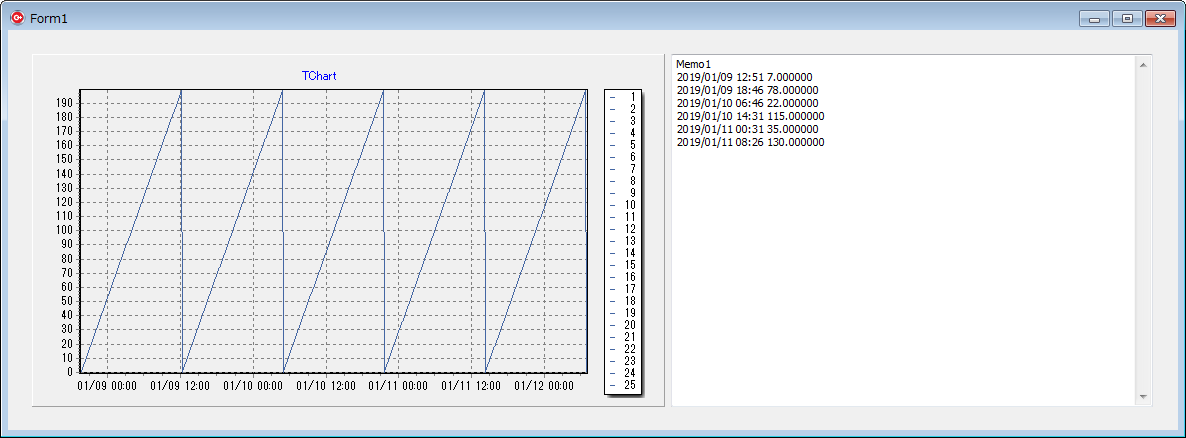動作環境
C++ Builder XE4
関連
- C > 配列の中から一番近い値を探索 (double型) > v0.1
- C++ Builder XE4 > TeeChart > 軸 > BottomAxisの開始日時と終了日時を取得する > Chart1->BottomAxis->Minimum と Maximum
- C++ Builder XE4 > TeeChart > 軸 > グラフをクリックした時、その地点の日時を計算する v0.1, v0.2
概要
- クリック地点のTDateTime値を計算
- その値に近い日時に対応するインデックスをSeries1から取得
- そのインデックスのSeries1のY値を取得し表示
関数 Search_binary()
UtilListSearch_double.cpp/.hにおいて実装している。
注意: この関数がないと下記の実装は動作しない
内容はC > 配列の中から一番近い値を探索 (double型) > v0.1のBinarySearch()と同じものであるが、C++ Builderで使うようにクラス化し、static関数としている(インスタンスでの使用は検討していない)。
実装 v0.1
Unit1.cpp
//---------------------------------------------------------------------------
# include <vcl.h>
# pragma hdrstop
# include <DateUtils.hpp>
# include "Unit1.h"
# include "UtilListSearch_double.h" // 自前実装の探索処理
//
//---------------------------------------------------------------------------
# pragma package(smart_init)
# pragma resource "*.dfm"
TForm1 *Form1;
//---------------------------------------------------------------------------
__fastcall TForm1::TForm1(TComponent* Owner)
: TForm(Owner)
{
}
//---------------------------------------------------------------------------
void __fastcall TForm1::FormShow(TObject *Sender)
{
Chart1->Series[0]->XValues->DateTime = true;
Chart1->BottomAxis->DateTimeFormat = L"mm/dd hh:nn";
TDateTime dt;
dt = Now();
double yval;
for (int idx=0; idx < 1000; idx++) {
yval = (1+ idx) % 200;
Series1->AddXY(dt, yval, "", clRed);
dt = IncMinute(dt, 5);
}
}
//---------------------------------------------------------------------------
void __fastcall TForm1::Chart1MouseUp(TObject *Sender, TMouseButton Button, TShiftState Shift,
int X, int Y)
{
String msg;
// 1. 開始日時と終了日時の表示
TDateTime startdt = Chart1->BottomAxis->Minimum;
TDateTime enddt = Chart1->BottomAxis->Maximum;
msg = L"[" + startdt.FormatString(L"yyyy/mm/dd hh:nn");
msg += L" to " + enddt.FormatString(L"yyyy/mm/dd hh:nn") + L"]";
Memo1->Lines->Add(msg);
// 2. クリックしたXから日時を計算
TDateTime dtclick = calcClickedDateTime(X, Chart1);
if (SecondsBetween(dtclick, 0) == 0) { // 範囲外
return;
}
msg = L"Click:" + dtclick.FormatString(L"yyyy/mm/dd hh:nn");
Memo1->Lines->Add(msg);
// 3. 近い日時のインデックスを探索し、Series1の値を表示
int idx = Chart_findIndex(dtclick, Series1);
if (idx >= 0) {
TDateTime findDt = Series1->XValue[idx];
msg = L"nearest:" + findDt.FormatString(L"yyyy/mm/dd hh:nn") +
L" [" + Series1->YValue[idx] + L"]";
Memo1->Lines->Add(msg);
}
}
TDateTime __fastcall TForm1::calcClickedDateTime(int Xpos, TChart *chrPtr)
{
// クリックした地点の日時を計算
if (chrPtr == NULL) {
return 0; // error
}
if (Xpos < chrPtr->ChartRect.left) {
return 0; // error
}
if (Xpos > chrPtr->ChartRect.right) {
return 0; // error
}
int xrange = chrPtr->ChartRect.Width(); // 日時の幅
int xclick = Xpos - chrPtr->ChartRect.Left; // クリック地点の開始日時からの幅 [単位:Xに基づく]
double ratio = (double)xclick / (double)xrange;
int elapsed = SecondsBetween(chrPtr->BottomAxis->Maximum, chrPtr->BottomAxis->Minimum) * ratio;
TDateTime dtclick; // クリック地点の日時
dtclick = IncSecond(chrPtr->BottomAxis->Minimum, elapsed);
return dtclick;
}
int __fastcall TForm1::Chart_findIndex(TDateTime clickDt, TFastLineSeries *serPtr)
{
// クリックした地点に近いSeriesの日時を探索
// Error時の戻り値: -1
if (serPtr == NULL) {
return -1; // error
}
double xvals[20000] = {0.0};
for(int idx=0; idx < serPtr->Count(); idx++) {
xvals[idx] = serPtr->XValue[idx];
}
// Note: [UtilListSearch_double]の関数を使用
int xpos = CUtilListSearchDouble::Search_binary(xvals, serPtr->Count(), clickDt);
return xpos;
}
//---------------------------------------------------------------------------
動作例
それぞれクリックしたところに近いSeries1のY値が表示されている。
(予定通りの結果となっている)
ClickとNearestの日時が異なるのは、dt = IncMinute(dt, 5);のようにSeries1は5秒おきのデータであるため。
実装 v0.2
- 変更
- Chart_getXYValue_nearest()に処理を抽出
Unit1.cpp
//---------------------------------------------------------------------------
# include <vcl.h>
# pragma hdrstop
# include <DateUtils.hpp>
# include "Unit1.h"
# include "UtilListSearch_double.h" // 自前実装の探索処理
//
//---------------------------------------------------------------------------
# pragma package(smart_init)
# pragma resource "*.dfm"
TForm1 *Form1;
//---------------------------------------------------------------------------
__fastcall TForm1::TForm1(TComponent* Owner)
: TForm(Owner)
{
}
//---------------------------------------------------------------------------
void __fastcall TForm1::FormShow(TObject *Sender)
{
Chart1->Series[0]->XValues->DateTime = true;
Chart1->BottomAxis->DateTimeFormat = L"mm/dd hh:nn";
TDateTime dt;
dt = Now();
double yval;
for (int idx=0; idx < 1000; idx++) {
yval = (1+ idx) % 200;
Series1->AddXY(dt, yval, "", clRed);
dt = IncMinute(dt, 5);
}
}
//---------------------------------------------------------------------------
void __fastcall TForm1::Chart1MouseUp(TObject *Sender, TMouseButton Button, TShiftState Shift,
int X, int Y)
{
double xval, yval;
bool res = Chart_getXYValue_nearest(X, Chart1, &xval, &yval);
if (res == false) {
return; // not found
}
// 結果の表示
TDateTime xdt = (TDateTime)xval;
String msg = xdt.FormatString(L"yyyy/mm/dd hh:nn") + L" " +
String().sprintf(L"%f", yval);
Memo1->Lines->Add(msg);
}
TDateTime __fastcall TForm1::calcClickedDateTime(int Xpos, TChart *chrPtr)
{
// クリックした地点の日時を計算
if (chrPtr == NULL) {
return 0; // error
}
if (Xpos < chrPtr->ChartRect.left) {
return 0; // error
}
if (Xpos > chrPtr->ChartRect.right) {
return 0; // error
}
int xrange = chrPtr->ChartRect.Width(); // 日時の幅
int xclick = Xpos - chrPtr->ChartRect.Left; // クリック地点の開始日時からの幅 [単位:Xに基づく]
double ratio = (double)xclick / (double)xrange;
int elapsed = SecondsBetween(chrPtr->BottomAxis->Maximum, chrPtr->BottomAxis->Minimum) * ratio;
TDateTime dtclick; // クリック地点の日時
dtclick = IncSecond(chrPtr->BottomAxis->Minimum, elapsed);
return dtclick;
}
int __fastcall TForm1::Chart_findIndex(TDateTime clickDt, TFastLineSeries *serPtr)
{
// クリックした地点に近いSeriesの日時を探索
// Error時の戻り値: -1
if (serPtr == NULL) {
return -1; // error
}
double xvals[20000] = {0.0};
for(int idx=0; idx < serPtr->Count(); idx++) {
xvals[idx] = serPtr->XValue[idx];
}
// Note: [UtilListSearch_double]の関数を使用
int xpos = CUtilListSearchDouble::Search_binary(xvals, serPtr->Count(), clickDt);
return xpos;
}
bool __fastcall TForm1::Chart_getXYValue_nearest(int Xpos, TChart *chrPtr, double *xdst, double *ydst)
{
if (chrPtr == NULL || xdst == NULL || ydst == NULL) {
return false; // error
}
// 1. クリックしたX位置から日時を計算
TDateTime dtclick = calcClickedDateTime(Xpos, chrPtr);
if (SecondsBetween(dtclick, 0) == 0) { // 範囲外
return false;
}
// 2. 近い日時のインデックスを探索し、Series1の値を格納
int idx = Chart_findIndex(dtclick, Series1);
if (idx < 0) { // not found
return false;
}
*xdst = Series1->XValue[idx];
*ydst = Series1->YValue[idx];
return true;
}
//---------------------------------------------------------------------------
実装 v0.3
- 変更
- Series1の定義を関数内で直接指定でなく、関数の引数で渡すようにした
- 他のSeriesを渡しやすくするため
- xvalsをnew/deleteで定義 (固定要素数の廃止)
- Qiita表示用にコード横幅を短く
- Series1の定義を関数内で直接指定でなく、関数の引数で渡すようにした
Unit1.cpp
//---------------------------------------------------------------------------
# include <vcl.h>
# pragma hdrstop
# include <DateUtils.hpp>
# include "Unit1.h"
# include "UtilListSearch_double.h" // 自前実装の探索処理
//
//---------------------------------------------------------------------------
# pragma package(smart_init)
# pragma resource "*.dfm"
TForm1 *Form1;
//---------------------------------------------------------------------------
__fastcall TForm1::TForm1(TComponent* Owner)
: TForm(Owner)
{
}
//---------------------------------------------------------------------------
void __fastcall TForm1::FormShow(TObject *Sender)
{
Chart1->Series[0]->XValues->DateTime = true;
Chart1->BottomAxis->DateTimeFormat = L"mm/dd hh:nn";
TDateTime dt;
dt = Now();
double yval;
for (int idx=0; idx < 1000; idx++) {
yval = (1+ idx) % 200;
Series1->AddXY(dt, yval, "", clRed);
dt = IncMinute(dt, 5);
}
}
//---------------------------------------------------------------------------
void __fastcall TForm1::Chart1MouseUp(TObject *Sender, TMouseButton Button, TShiftState Shift,
int X, int Y)
{
double xval, yval;
bool res = Chart_getXYValue_nearest(X, Chart1, Series1, &xval, &yval);
if (res == false) {
return; // not found
}
// 結果の表示
TDateTime xdt = (TDateTime)xval;
String msg = xdt.FormatString(L"yyyy/mm/dd hh:nn") + L" " +
String().sprintf(L"%f", yval);
Memo1->Lines->Add(msg);
}
TDateTime __fastcall TForm1::Chart_calcClickedDateTime(int Xpos, TChart *chrPtr)
{
// クリックした地点の日時を計算
if (chrPtr == NULL) {
return 0; // error
}
if (Xpos < chrPtr->ChartRect.left) {
return 0; // error
}
if (Xpos > chrPtr->ChartRect.right) {
return 0; // error
}
int xrange = chrPtr->ChartRect.Width(); // 日時の幅
int xclick = Xpos - chrPtr->ChartRect.Left; // クリック地点の開始日時からの幅 [単位:Xに基づく]
double ratio = (double)xclick / (double)xrange;
TDateTime startdt = chrPtr->BottomAxis->Minimum;
TDateTime enddt = chrPtr->BottomAxis->Maximum;
int elapsed = SecondsBetween(enddt, startdt) * ratio;
TDateTime dtclick; // クリック地点の日時
dtclick = IncSecond(chrPtr->BottomAxis->Minimum, elapsed);
return dtclick;
}
int __fastcall TForm1::Chart_findIndex(TDateTime clickDt, TFastLineSeries *serPtr)
{
// クリックした地点に近いSeriesの日時を探索
// Error時の戻り値: -1
if (serPtr == NULL) {
return -1; // error
}
int numXval = serPtr->Count();
double *xvals = new double[numXval];
for(int idx=0; idx < numXval; idx++) {
xvals[idx] = serPtr->XValue[idx];
}
// Note: [UtilListSearch_double]の関数を使用
int xpos = CUtilListSearchDouble::Search_binary(xvals, numXval, clickDt);
delete [] xvals;
return xpos;
}
bool __fastcall TForm1::Chart_getXYValue_nearest(int Xpos, TChart *chrPtr,
TFastLineSeries *serPtr, double *xdst, double *ydst)
{
if (chrPtr == NULL || serPtr == NULL ||
xdst == NULL || ydst == NULL) {
return false; // error
}
// 1. クリックしたX位置から日時を計算
TDateTime dtclick = Chart_calcClickedDateTime(Xpos, chrPtr);
if (SecondsBetween(dtclick, 0) == 0) { // 範囲外
return false;
}
// 2. [serPtr]の値から近い日時のインデックスを探索し、X,Y値を格納
int idx = Chart_findIndex(dtclick, serPtr);
if (idx < 0) { // not found
return false;
}
*xdst = serPtr->XValue[idx];
*ydst = serPtr->YValue[idx];
return true;
}
//---------------------------------------------------------------------------

